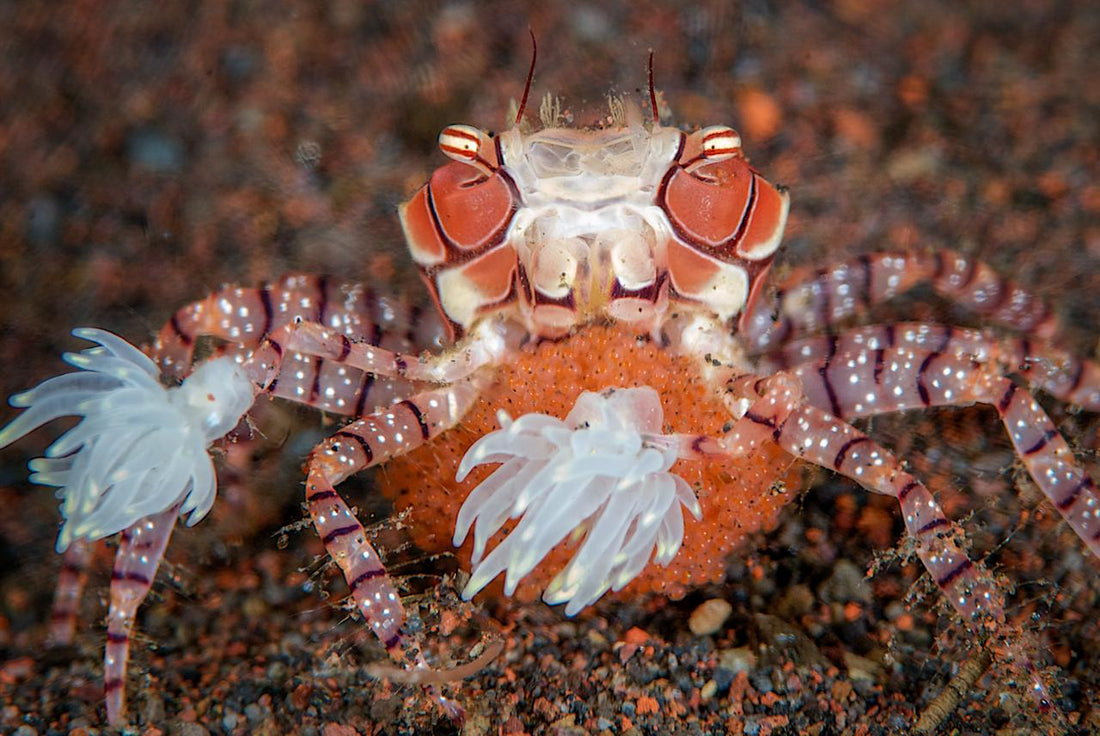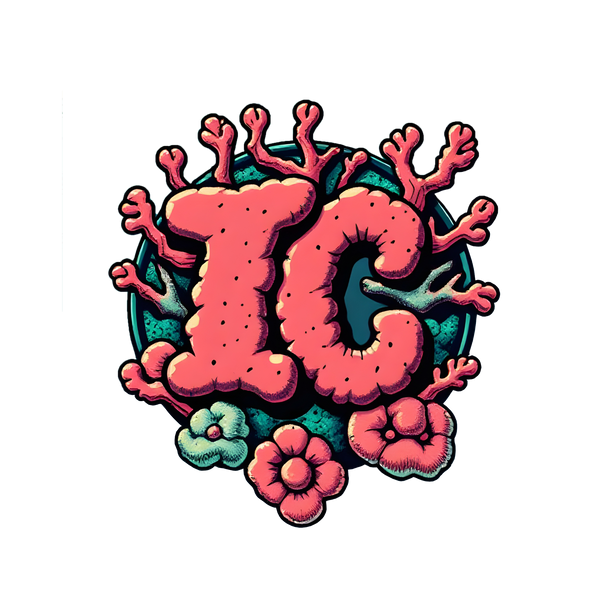
Creature Feature: The Pom-Pom Crab
Tiny Fighter, Big Personality
Meet the Pom-Pom Crab
Picture a crab in boxing gloves — now make it cute, about the size of a nickel, and ready to fight for its life. That’s the Pom-Pom Crab (genus: Lybia), one of the ocean’s most charismatic crustaceans. Armed with living sea anemones in each claw, this pint-sized prizefighter wields a pair of natural stun guns — not for sport, but for survival.
Commonly found across shallow coral reefs in the Indo-Pacific, particularly around the Red Sea and East Africa, Pom-Pom Crabs are more than just adorable oddities. They’re a brilliant example of symbiosis in action — and they’ve earned cult status among saltwater aquarists for good reason.

The Pom-Pom Crab, Lybia tessellata, always brings its own entourage — two live sea anemones, wielded like electrified mittens.
The Crab with Gloves That Sting
The Pom-Pom Crab’s signature move isn’t just for show. It literally holds sea anemones in its claws, using them for both offense and defense. When threatened, it waves the anemones around to deter predators — essentially saying, “Back off, I’m armed.”
The anemones (Bunodeopsis spp. or similar) pack a mild sting and add a layer of protection the crab couldn’t muster on its own. But here’s the kicker: they aren’t permanently attached. The crab actually carries them around like prized possessions, and if one is lost, the crab will split the remaining anemone in two — cloning it to restore its symmetrical swagger.
Talk about resourceful.
This mutualistic relationship gives the anemones a ride to prime reef real estate (and all the snacks that come with it), while giving the crab enhanced defense — and, let’s be honest, major style points.
These tiny crustaceans can be found across the Indo-Pacific, from the coral reefs of the Red Sea and East African coast all the way to the biodiverse waters surrounding Indonesia and New Guinea. They prefer sheltered, rocky reef environments where they can scuttle around under coral ledges, inside small crevices, or occasionally hitchhike inside the tentacles of larger anemones.

Big attitude, tiny claws. This pom-pom crab is smaller than a fingertip—but it’s armed and fabulous with living anemone gloves. Nature doesn’t do subtle
Anatomy of a Pom-Pom
Though they’re usually only 1–2 cm across, Pom-Pom Crabs have a surprisingly complex appearance. Their carapace is patterned like tiny tile mosaics — usually brown, cream, and orange — giving them excellent camouflage in reef rubble. Eight skinny legs allow for speed and agility, but the real showstoppers are those delicate claws, forever holding pom-poms of stinging tentacles.
In aquariums, they’re mostly nocturnal — hiding by day and emerging at night like tiny crustacean ninjas. Their behavior is fascinating to watch, and despite their fierce looks, they’re peaceful and reef-safe, making them popular (if rare) additions to nano tanks and coral reefs alike.
What They Eat (and What Eats Them)
Pom-Pom Crabs are omnivores and scavengers. They’ll eat:
-
Detritus
-
Leftover fish food
-
Algae
-
Tiny invertebrates
They use their anemones to grab food from the water column or reef surface, waving them like jellyfish-fueled vacuum cleaners.
But life isn’t easy when you’re this small. Their predators include:
-
Wrasses
-
Crabs and mantis shrimp
-
Large invertebrates
-
Opportunistic fish
Luckily, the crab’s excellent camouflage and shocking defense tools give them a fighting chance — especially when wedged into live rock and waving their nem-ny fists like they just don’t care.
Keeping One at Home
For reefkeepers, Pom-Pom Crabs are quirky little gems. If you're lucky enough to find one (they’re not super common in the hobby), here’s what they need:
-
Tank Size: 10 gallons or more
-
Temperatures: 75–80°F (24–27°C)
-
Diet: Scavenged or target-fed bits of meaty food
-
Behavior: Peaceful, cryptic, reef-safe
-
Compatibility: Avoid larger predatory fish or aggressive inverts
They’re best kept solo or with similarly peaceful tank mates. Watching one emerge from its rock fortress, pom-poms pulsing under the moonlight, is a genuinely rewarding sight for hobbyists.
“Pom-Pom Crabs are one of the most fascinating examples of natural tool use in marine inverts,” says Dr. Shelby Hawthorne, an invertebrate specialist. “They demonstrate behavior that borders on intelligence — cloning their tools, selectively using them, and forming symbiotic partnerships.”
Why They Matter
Besides being adorable, Pom-Pom Crabs shine a spotlight on the intelligence and complexity of even the tiniest reef dwellers. Their partnership with anemones is a prime example of mutualism, a natural strategy that allows two species to benefit and survive together.
In a world of pollution, bleaching, and ecosystem collapse, creatures like the Pom-Pom Crab remind us that the reef is a place of relationships — not just fish and coral, but delicate alliances built over millennia.
And when reefs vanish, so do these stories.
🧵 Tying It All Together: What Can You Do?
At Immoral Coral, we don’t just admire these creatures — we fight for them.
Our shirts aren’t just fashion statements. They’re protest signs in disguise. Made from 6 ocean-bound plastic bottles, 25% organic cotton, and 25% modal every tee helps reduce the kind of waste that smothers habitats like the Pom-Pom Crab’s reef.
Wearing one is like raising your claws in solidarity:
✊ For reefs
✊ For coral
✊ For the little fighters with sea anemones for gloves
So if you’ve ever wondered whether you can make a difference from your couch, your tank, your local beach cleanup — the answer is yes. You’re already doing it.
🔗 Join the Rebellion. Save the Reef.
👉 Shop Immoral Coral
📸 Follow us on Instagram
